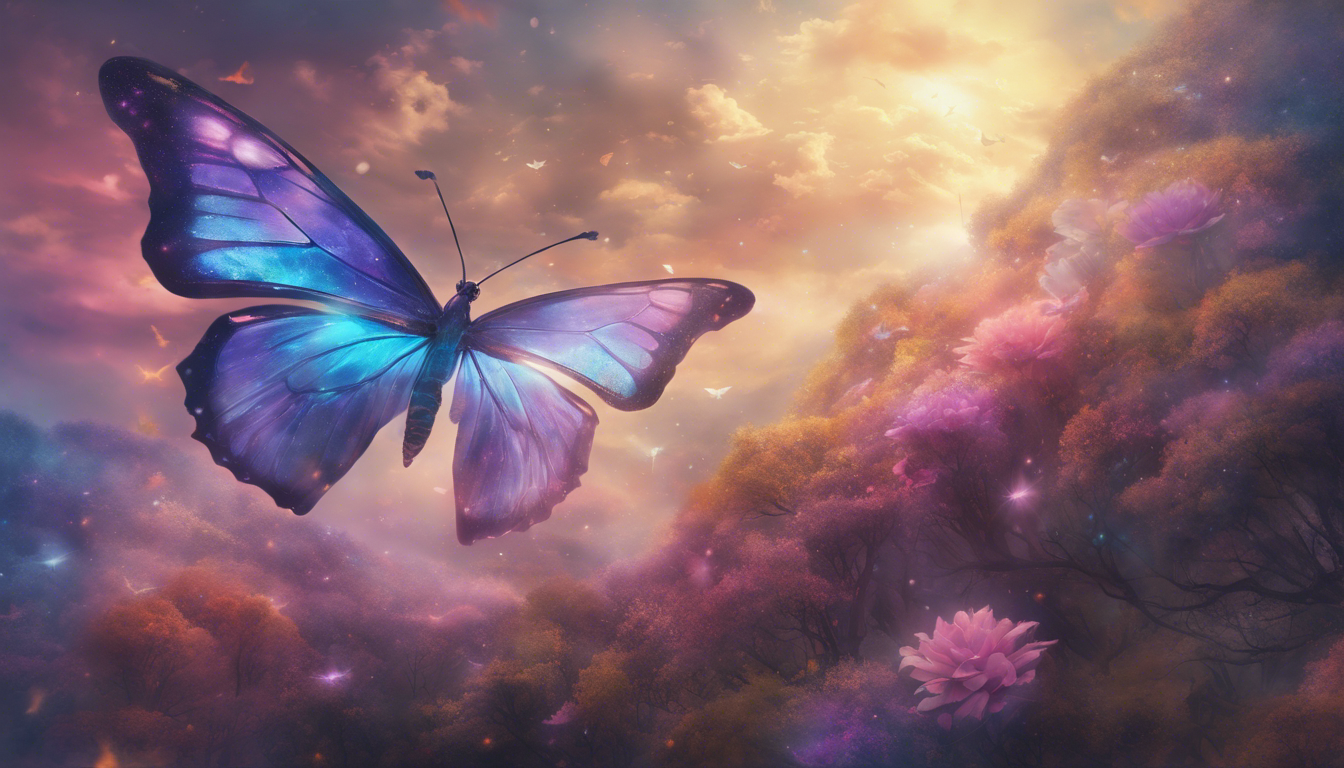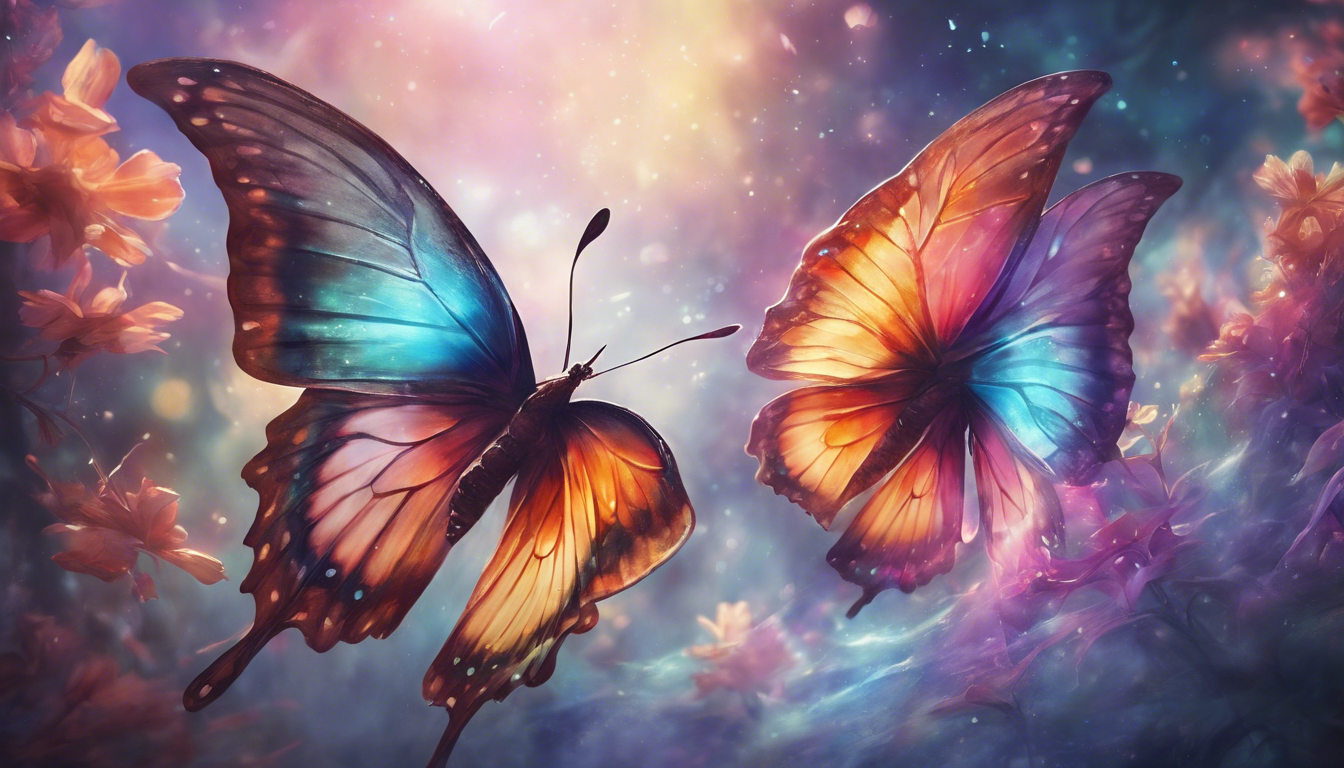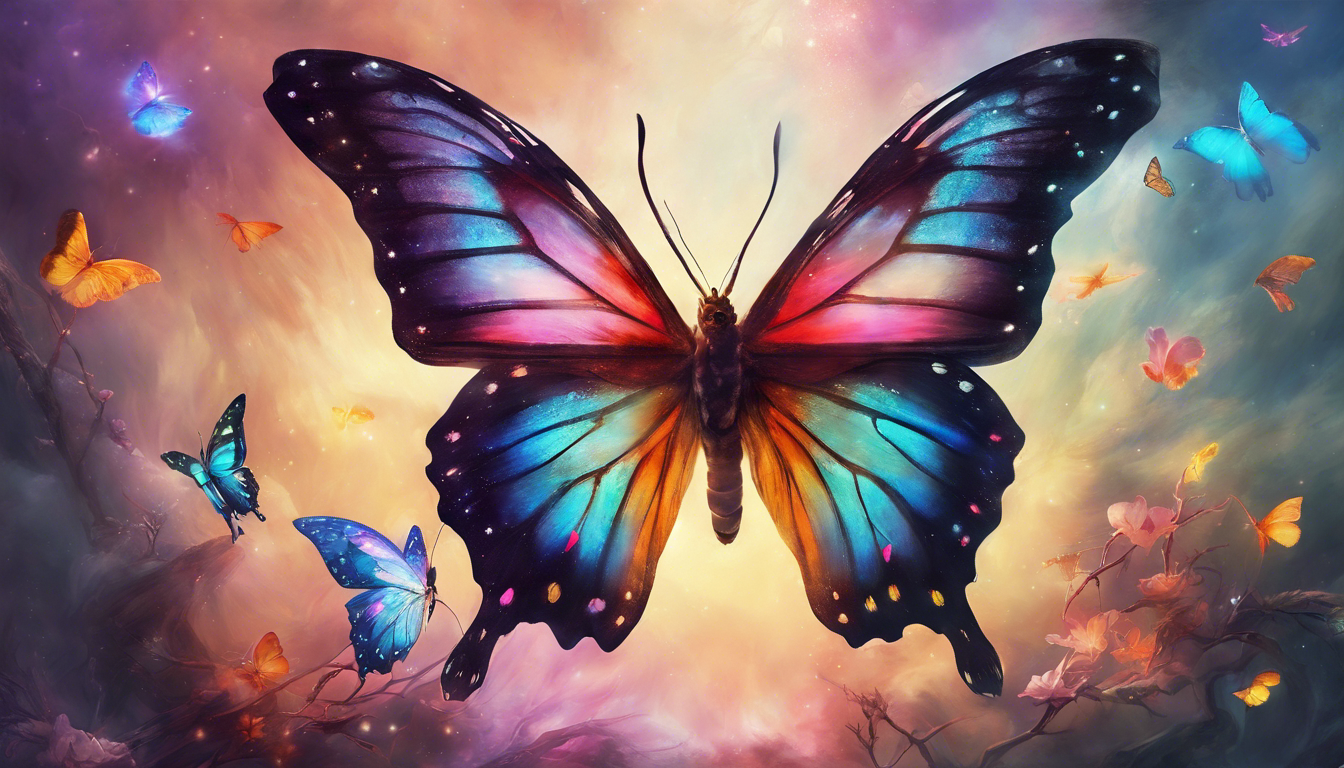The Fascinating Symbolism Behind Butterfly Colors
The Symbolism of Colors in Butterflies
Butterflies are not only beautiful creatures that grace our gardens and meadows, but they also have deep symbolism attached to their vibrant colors. Each color on a butterfly’s wings carries a unique meaning and significance. Let’s delve into the mesmerizing world of butterfly colors and decipher their symbolism.
The Color Spectrum of Butterflies
The color spectrum exhibited by butterflies is truly awe-inspiring. From vivid reds and oranges to vibrant blues and delicate pastels, butterflies showcase a breathtaking array of hues. Let’s explore the symbolism behind some of the most common colors found in these enchanting creatures.
1. Red
The color red in butterflies represents passion, love, and strength. It is often associated with intense emotions and fiery energy. When a butterfly with red wings crosses your path, it may be a sign to embrace your passions and pursue your dreams.
2. Orange
Orange butterflies symbolize joy, creativity, and enthusiasm. They bring a sense of optimism and warmth into our lives. When an orange butterfly flutters by, it may be a gentle reminder to stay positive and embrace the beauty of life.
3. Yellow
Yellow butterflies are often associated with happiness, optimism, and new beginnings. They symbolize sunshine and radiate a sense of positivity. When you spot a yellow butterfly, it may be a sign that a period of joy and transformation is on its way.
4. Blue
Blue butterflies are considered spiritual symbols and are associated with tranquility, calmness, and intuition. They often represent spiritual growth and wisdom. When a blue butterfly crosses your path, it may be a message to trust your intuition and embark on a journey of self-discovery.
5. Green
Green butterflies symbolize growth, fertility, and abundance. They are often associated with the natural world and represent harmony and balance. When a green butterfly appears, it may be a reminder to connect with nature and nurture your own growth.
6. Purple
Purple butterflies carry a sense of magic and spirituality. They represent transformation and enlightenment. When a purple butterfly graces your presence, it may be a sign that you are undergoing a spiritual awakening or experiencing a profound change in your life.
7. White
White butterflies symbolize purity, innocence, and spiritual guidance. They are often associated with angelic energies and represent a connection to the spiritual realm. When a white butterfly crosses your path, it may be a sign of divine intervention or the presence of a loved one in spirit.
8. Black
Black butterflies are often seen as mysterious and represent transformation and rebirth. They symbolize the end of one chapter and the beginning of another. When a black butterfly appears, it may be a sign that it’s time to let go of the past and embrace the changes that lie ahead.
In conclusion, the colors of butterflies hold immense symbolism and can serve as powerful messengers in our lives. Whether they represent love, joy, spirituality, or transformation, these exquisite creatures remind us of the beauty and magic that surrounds us. So, the next time a butterfly graces your presence, take a moment to appreciate its colors and the message it may be carrying for you.
The Significance of Different Butterfly Colors in Cultures Around the World

The Beauty of Butterfly Colors
Butterflies have captivated the human imagination for centuries with their enchanting colors and delicate movements. These colorful creatures have long been associated with transformation, grace, and freedom. However, did you know that the colors of butterflies also hold deep symbolic meanings in cultures around the world? Each hue represents something unique and significant, making these insects even more fascinating.
The Symbolism of Butterfly Colors
In many cultures, butterflies are seen as spiritual or even divine symbols. The color of a butterfly is believed to reflect its spiritual significance and is often associated with different aspects of life and emotions.
1. White Butterflies: White butterflies are often associated with purity, innocence, and spiritual transformation. In many cultures, they are seen as messengers from the spirit world, carrying messages of guidance and protection.
2. Yellow Butterflies: Yellow butterflies symbolize joy, happiness, and optimism. Their bright and cheerful colors are often associated with positivity and good luck. In some cultures, yellow butterflies are also seen as a sign of hope and new beginnings.
3. Red Butterflies: Red butterflies represent passion, love, and strong emotions. Their vibrant color is often associated with intense feelings and desires. In certain cultures, red butterflies are believed to be messengers of love and romance.
4. Blue Butterflies: Blue butterflies are often associated with calmness, serenity, and spiritual growth. Their tranquil hue is believed to bring peace and harmony to those who encounter them. In some cultures, blue butterflies are seen as a symbol of good fortune and protection.
5. Black Butterflies: Black butterflies symbolize mystery, transformation, and rebirth. Their dark color often represents the unknown and the hidden aspects of life. In certain cultures, black butterflies are seen as a symbol of profound change and personal growth.
The Cultural Variations
While the general symbolic meanings of butterfly colors might be similar across various cultures, there can be slight variations in interpretation.
For example, in Western cultures, blue butterflies are often associated with sadness or melancholy. In contrast, many Asian cultures see blue butterflies as a symbol of good luck and prosperity.
In Native American cultures, black butterflies are often seen as a symbol of endurance and resilience, representing the ability to overcome challenges and transform oneself.
Similarly, the symbolic meanings of butterfly colors can also vary within different spiritual and belief systems. It is important to remember that interpretation is subjective and can differ from person to person.
Butterfly Colors in Your Life
Whether you believe in the spiritual symbolism of butterfly colors or simply appreciate their beauty, these delicate creatures can bring joy, inspiration, and a sense of wonder to our lives.
Next time you encounter a butterfly in nature, take a moment to observe its colors and reflect on the emotions and meanings they might represent. Embrace the transformative power of butterflies and let their vibrant hues brighten your day.
In cultures around the world, the colors of butterflies hold significant symbolic meanings. From white representing purity to black symbolizing transformation, the hues of these enchanting creatures carry deep spiritual and emotional importance.
By understanding the significance of butterfly colors, we can gain a deeper appreciation for the beauty and symbolism they represent. So, the next time a butterfly crosses your path, take a moment to marvel at its colors and the profound messages it might be carrying. After all, butterflies are not just beautiful creatures, but also messengers from a world of deeper meaning.
Exploring the Psychological Meanings of Butterfly Colors

Butterflies are not only beautiful creatures; they also carry symbolic meanings that can have a powerful impact on our psyche. One aspect that contributes to their allure is the wide variety of colors they display. Each color has its own psychological significance, evoking various emotions, moods, and feelings. In this article, we will delve into the profound meanings behind the colors of butterflies and how they can illuminate our understanding of ourselves.
The Unmistakable Power of Red
Red is a color that demands attention and is often associated with passion, energy, and power. When we think of red butterflies, we are reminded of fierce determination and vitality. The vibrant hue symbolizes action, strength, and strong emotions. Red butterflies can serve as a reminder to embrace our passions, pursue our dreams, and tap into our inner power to manifest change in our lives.
Serenity in Shades of Blue
Blue butterflies, with their serene and calming presence, bring a sense of tranquility and peace. Blue is often associated with stability, harmony, and introspection. These butterflies can inspire us to find inner peace and foster clear communication. They encourage us to tap into our intuition and trust the guidance that comes from within.
The Joyful Vibrancy of Yellow
Yellow butterflies radiate sunshine and joy wherever they go. This vibrant color represents happiness, optimism, and positivity. Yellow butterflies remind us to embrace the simple pleasures of life and cultivate a positive mindset. They encourage us to let go of negativity and find the beauty in every moment.
Embracing Transformation with Green
Green butterflies symbolize growth, renewal, and transformation. They remind us of the cycles of life and the importance of adapting and evolving. Green is associated with healing, abundance, and prosperity, inviting us to embrace change and seek new opportunities. These butterflies encourage us to let go of the past and step into a new phase of life.
Mystery and Magic in Purple
Purple butterflies exude an air of mystery and magic. This regal color represents spirituality, intuition, and mysticism. Purple butterflies inspire us to connect with our higher selves and explore the realms of the unknown. They encourage us to trust our intuition and follow the whispers of our soul.
Balance and Harmony in White
White butterflies symbolize purity, innocence, and spiritual awakening. They carry a sense of peace and purity, inviting us to let go of attachments and embrace simplicity. White butterflies remind us to find balance and harmony in our lives and connect with our higher purpose.
The colors of butterflies hold deep psychological meanings that elicit powerful emotions within us. By exploring and understanding these meanings, we can tap into our own inner wisdom and unlock a deeper understanding of ourselves. Whether it’s the fiery red, tranquil blue, joyful yellow, transformative green, mystical purple, or pure white, each color offers a unique message of growth, inspiration, and self-discovery. So, the next time you encounter a butterfly, take a moment to appreciate its colors and the profound impact they can have on your own psychological journey.
Understanding the Role of Environmental Factors in Butterfly Coloration

The Colorful World of Butterflies
Butterflies have always fascinated humans with their stunning and vibrant colors. These colors serve a variety of functions, from attracting mates to camouflaging against predators. While genetic factors play a significant role in butterfly coloration, environmental factors also play a crucial role in shaping their colors.
1. The Influence of Temperature
One of the key environmental factors that affect butterfly coloration is temperature. Temperature can influence the development and expression of pigments in butterfly wings. Warmer temperatures during the pupal stage, for example, can result in more intense and vibrant colors.
Additionally, temperature can also affect the ratio of different pigments present in butterfly wings. For instance, cooler temperatures can lead to an increase in the production of melanin, resulting in darker wing coloration.
2. The Role of Light
Light is another environmental factor that significantly influences butterfly coloration. Different wavelengths of light are absorbed or reflected by the pigments in butterfly wings, creating the dazzling array of colors that we see.
The angle at which light hits butterfly wings can also impact color perception. Certain butterflies possess microscopic structures on their wings that can reflect light at specific angles, resulting in iridescent colors. This phenomenon is known as structural coloration and is influenced by environmental factors such as humidity and air pollution.
3. Diet and Coloration
The food that butterflies consume during their larval stage can also affect their coloration. Certain plants contain pigments that are incorporated into the developing wings of caterpillars. For example, monarch butterflies feed on milkweed, which contains a chemical compound called cardenolide. This compound not only makes monarch butterflies toxic to predators but also influences their bright orange coloration.
Moreover, the availability of certain nutrients in the diet can impact the overall health and development of butterflies, consequently influencing their coloration. A well-balanced diet can result in vibrant and striking wing colors, while a lack of essential nutrients may lead to dull or faded colors.
4. Habitat and Adaptation
Butterflies have evolved to thrive in diverse habitats, and their coloration is often adapted to suit specific environments. In environments with dense vegetation or foliage, butterflies may display cryptic coloration to blend in with their surroundings and avoid detection by predators. On the other hand, in open and brightly lit habitats, butterflies may exhibit vibrant colors to attract mates.
The habitat in which butterflies live also determines the availability of certain pigments. For instance, butterflies living in areas with high levels of specific pigments in the plants they feed on may accumulate those pigments, resulting in distinct wing coloration.
The coloration of butterflies is a subject of both genetic and environmental influences. Understanding the role of environmental factors in butterfly coloration provides us with insights into the fascinating adaptations of these creatures. By studying and appreciating the intricate relationship between butterflies and their environment, we can gain a deeper understanding of the natural world around us.


Article written by Dera
Greetings, I am Dera, a 35-year-old individual with a deep passion for spirituality. Through my website, I aim to share my insights and knowledge to help others on their spiritual journey. Join me on the path to inner peace and enlightenment.